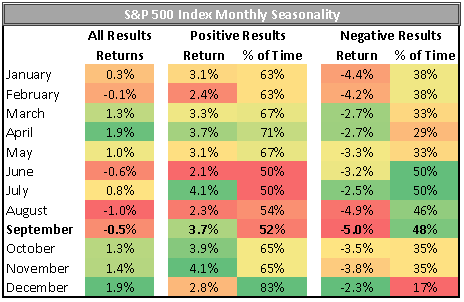How to Profit From Seasonal Volatility (VIX)
Post on: 18 Июль, 2015 No Comment

Recent Posts:
Market Sentiment How to Profit From Seasonal Volatility
When sentiment changes and fear grips market participants, they generally sell riskier assets such as stocks, and run for the safety of safe-haven assets.
Thing is, as investors look for protection from their riskier assets, the demand for portfolio protection rises and that buoys the value of options premiums.
Historically, investors exit stocks during the summer months, and seasonal studies show that July is one of the most volatile months. So, now would seem an appropriate time to look at how seasonality and volatility play together and what you can do about it.
Seasonality
The seasonality of a security describes the performance of that security during a given period of time. One common method used to analyze seasonal returns evaluates the average return of a security as well as the percent of times the returns are positive or negative during a specific period.
In my opinion, when evaluating the seasonal nature of the returns of a security an analyst should focus on periods of more than 10 years. An analysis of anything less could lead to unreliable results.
Volatility
There are two types of volatility that market participants generally focus on: include implied volatility and historical volatility.
Historical volatility is a measurement of the actual movement of a security calculated by looking in the rear view mirror.
Implied volatility is the markets estimate of future movements of a security.
An index that measures the implied volatility of the S&P 500 Index is the CBOE Volatility Index . often referred to as the VIX, or the fear index. This index measures the implied volatility of the “at-the-money strike prices” of the S&P 500. As the VIX increases, implied volatility on the S&P 500 increases; when the VIX is falling, implied volatility on the S&P 500 index is falling.
A higher VIX generally coincides with increasing fear among market participants (hence the fun moniker), and usually moves in tandem with large swings in the daily percentage returns of the S&P 500 index.
Analyzing the Results
A seasonal investment is theoretically profitable if the returns are positive more than 50%, and the average return is greater than zero. Obviously when evaluating the average return, an analyst should look to see if there are outliers that are making the average return larger or smaller.
The chart of a seasonal analysis of the CBOE Volatility Index shows that the VIX increases nearly 13.3 points 75% of the time in July over the past 20 years.
So How Can an Investor Profit From This Analysis?
The seasonal analysis shows a statistically significant evaluation in which the VIX is likely to climb during July. To take advantage of this potential outcome, an investor can purchase a fund that increases in value when the VIX climbs. Short-term VIX ETFs and exchange-traded notes (ETNs) track the performance of the VIX futures contracts, which are correlated to the movements of the VIX index.
The iPath S&P 500 VIX Short-Term Futures ETN (VXX ) was at the forefront of VIX-related products, and is geared toward investors seeking out volatility exposure. With the VXX hitting all-time lows, I would purchase the ETF below $27.75, looking for it to rally back to resistance near the 50-day moving average at $34.35. I would exit the position on a close below $25 or when the calendar turns to August.
An alternative is the iPath S&P 500 VIX Mid-Term Futures ETN (VXZ ), which provides a similar exposure but holds differed VIX futures contracts as opposed to short term futures contracts.
At the time of writing the piece, I do not hold any positions in VXX or VXZ














